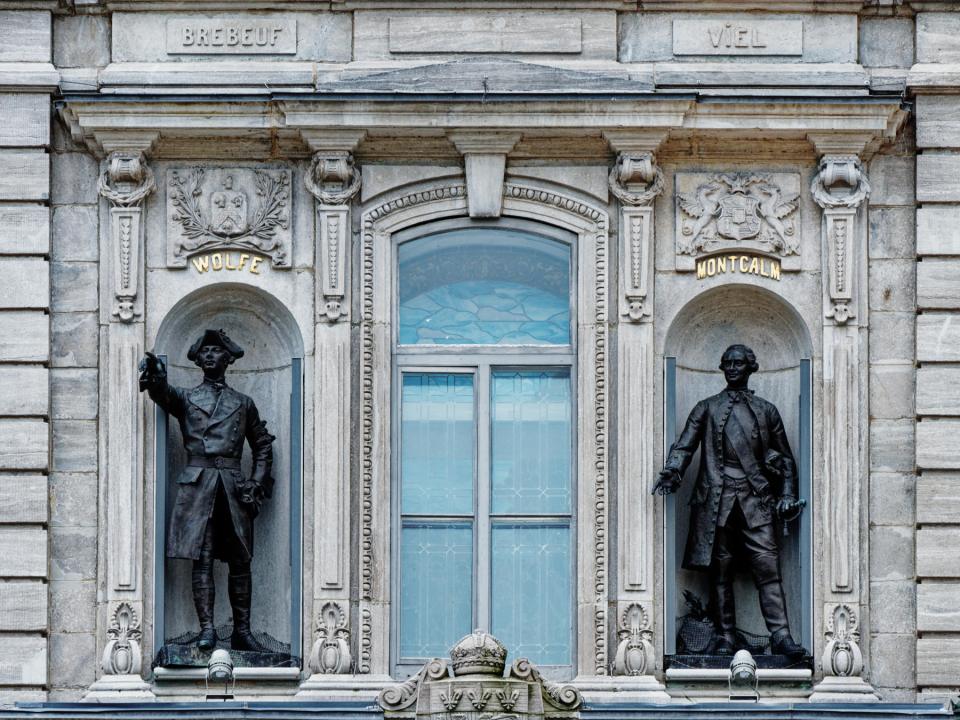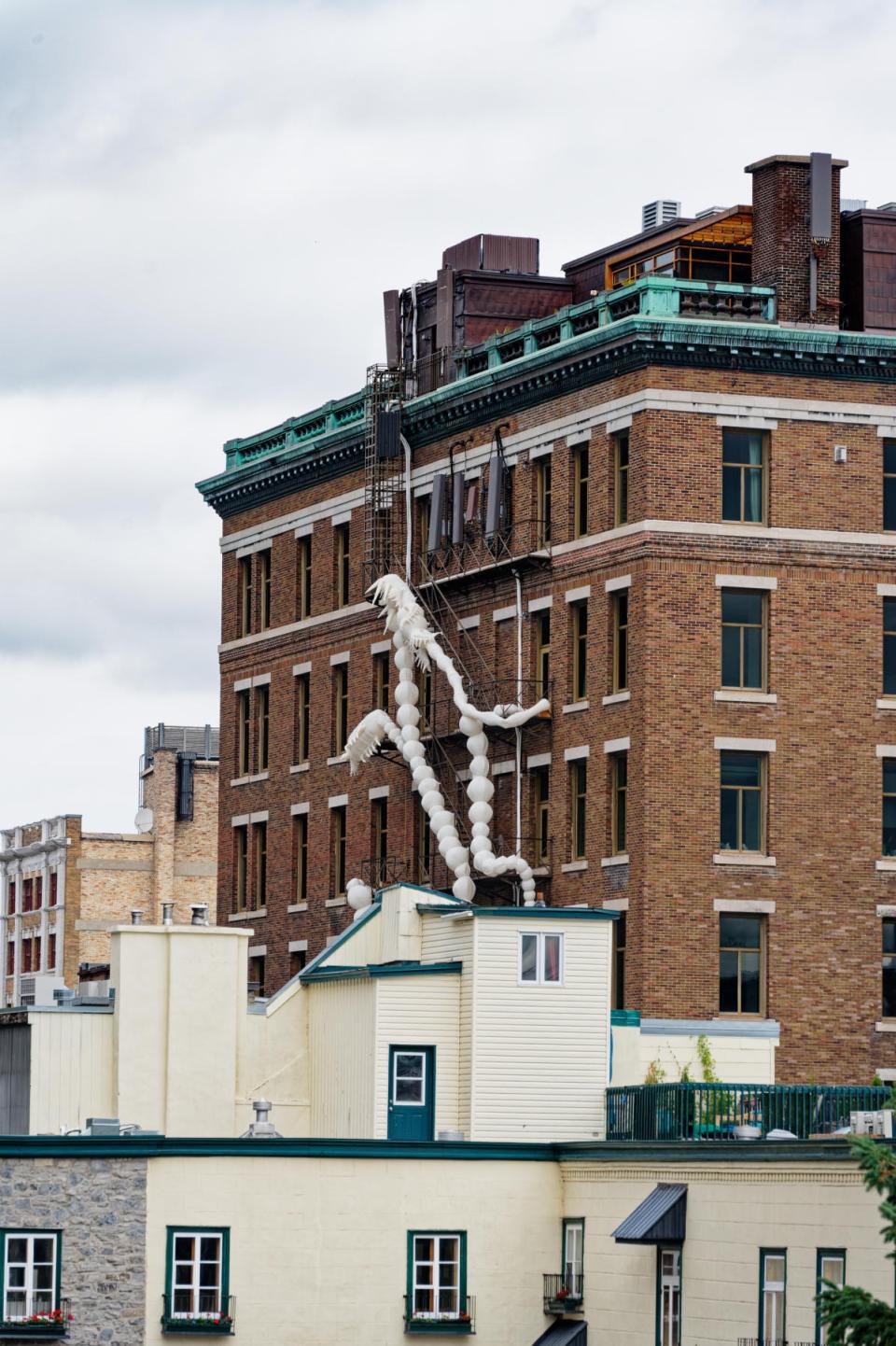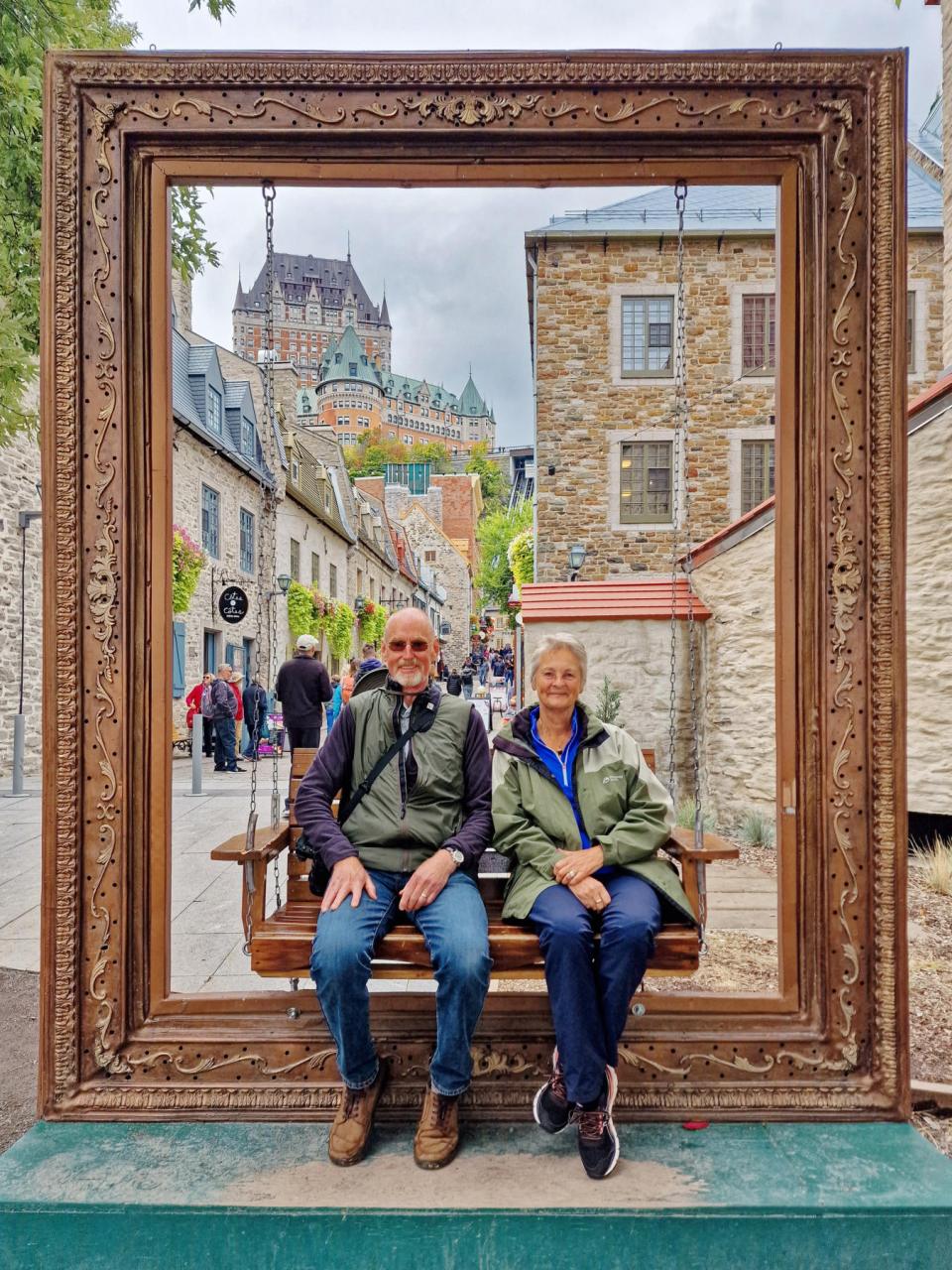Wednesday 21 September 2022 – Our second and final day in Québec dawned fine and sunny (according to the UK Met Office) or at least not raining (according to looking out of the hotel window). Given that it’s such a historic, individual and photogenic city, we felt we had to get out and explore; Jane had some specific sights she wanted to see as part of any wanderings on our part. To aid us in our quest to find out more about the place, we joined another “free” walking tour, this one led by Sam

who described himself as having a beard and a sense of humour – accurate in both cases, as it turns out. He was full of knowledge and amusing ways of putting stories across, often referring to the city’s official motto – “Je me souviens” – I remember.
To start with, we had to find Sam. The appointed meeting place was the fountain by the national assembly building

to reach which we walked up Rue St-Louis, which is an attractive street


containing the city’s oldest house

and its own city gate.

(not the original one – Sam explained that originally there was a much narrower opening, as befits a gate designed to restrict city access. After the British defeated the French here in 1759, they bolstered the defences in order (successfully) to resist the subsequent French siege. The city walls were saved from destruction in the late 19th century by the then Governor General of Canada, Lord Dufferin, who was enough of a visionary to realise the value of future tourism and so had the walls preserved and the gates widened to open the city to visitors). The fortifications, along with the rest of Old Québec, were designated an UNESCO World Heritage Site in 1985 and remain the only intact fortified colonial settlement in North America north of Mexico.
The National Assembly building has several statues in niches all over its façade. Sam identified two of them.

On the left – General Wolfe, the winner of the British fight for Quebec; on the right, the Marquis de Montcalm. History is written by the victors, and it’s unusual, and rather refreshing, to see any recognition on historic buildings of the people who came second. I think this is possibly a reflection of the thoughtful approach that Canadians seem to take to many aspects of life.
Sam is obviously a film buff, as he referred to a couple of films during his tour. One of them was “Catch Me If You Can“, a caper in which Tom Hanks tries to nab Leonardo DiCaprio as he blags his way across the world. The other was an Alfred Hitchcock thriller called “I confess“, about the dilemma facing a priest who receives confession from a murderer. Sam showed us the actual house where the “murder” was committed, something other guided tours don’t cover.

The current occupant of the house is clearly familiar with Sam leading tours past his house, as he came to the window and waved to us all.
Our tour then passed between two libraries – a modern one housed in an old French church and an old one housed in a more modern building which was originally a gaol.

Passing the Clarendon hotel, a building on a site with history that goes back as far as 1685, and is thus far older than the ancient-looking Chateau Frontenac

our next stop was at the Town Hall.

It’s a very imposing building, and doubtless Sam dispensed some interesting nuggets about it; but I became fascinated by its fountains.
After this, we headed (past a building with a very bizarre artwork attached to it)

towards Old Québec,

which is (a) historic, (b) photogenic and (c) contains many of the things Jane wanted to see. These included the “Breakneck Steps”, the city’s oldest steps, so called because they were once rather rickety as well as steep;

then round the corner to this:

which, presented as above (with some photoshoppery), looks like a city scene, but is actually the Québec city mural, telling the story of Québec;

indigenous artwork in a street off Place Royale;

and another wonderful building-side mural

(again, here, with image manipulated – it really looks as below).

The whole area is desperately photogenic

and gives what Sam asserts is the best view of the Chateau Frontenac – and who am I to argue?

Trees in the above photo actually hide the Funicular, which people can use to travel up to the hotel square if they are prepared to pay the 4 CAD fare.

The Place Royal features the outline of where the first building in Québec stood

and Sam pointed out that this was where Tom Hanks and Leonardo DiCaprio actually stood during the filming of “Catch Me If You Can“. Just round the corner is the ultimate Selfie Spot,

where one can ruin a perfectly decent city scene by appearing in it, on the Old City Centre Swing. There are any number of photo opportunities around this part, and the place really, really feels like Paris.
It isn’t, of course, but is often used in films to portray France. In the above, the piano accordion is actually an electronic instrument and you can’t move far without the smell of popcorn pervading the air – giveaways that you’re not in France after all. (Another one is the ubiquity of tin roofs; in France, lead is more commonly used.)
That ended Sam’s entertaining and informative tour, so we headed back up to the hotel up the

172 steps you need to climb.
For once, instead of eating at the hotel, good as its meals are, we had booked an early dinner outside, at a place recommended by Ian Burley called Le Hobbit. The restaurant is in Rue St-Jean, which gave us an opportunity to walk to it past the Observatoire de la Capitale, which is on the 31st floor of a building next to the National Assembly. So once again we headed up Rue St-Louis, pausing to take a photo of Churchill and Roosevelt

(these sculptures celebrating their meeting here in 1943 to plan the D-Day Landings) and found our way to the top of the Observatoire building. One needs to book, and, helpfully, there’s a QR code on the ground floor for paying one’s entrance. But we didn’t have internet access, and it needed help from a sympa young chap who was guarding the Observatoire on the top floor to help us pay our entrance fees. That achieved, we had a few minutes to wander the four sides of the Observatoire, looking at the views of the city around us.


Then we crossed to Rue St-Jean, which is jolly picturesque,



includes the Church of St. John the Baptist which gives the street its name

and has some interesting shop windows.


We had a very good meal at Le Hobbit (thanks, Ian). Then we wandered back to the hotel in the gathering gloom, via the Old Town, to see if it was as picturesque at night as it is during the day.


This signalled the end of our time in Québec, as we had to be ready to catch an earlyish train to Montréal the next morning. It would have been nice to have had more time to explore – a lesson learned for future holidays of the pith and moment of this one – but it was lovely to have seen what we did. Jane thought that maybe it was just a little bit too picture perfect, but I loved the place. Maybe we’ll be back; who knows? But tomorrow is onward! to Montréal, so please come back to see what we made of things there.















































 (above imaginatively called “Bear Catching Fish)
(above imaginatively called “Bear Catching Fish)
 (The above is called “Our Shepherds”. The accompanying description says “The playful blue colour and simple, symmetrical structure of the sculpture acts as an enticement to consider deeper meanings. Our Shepherds speaks of those who take power and those who are led, inviting viewers to question who are the shepherds and who are the sheep.” This is a load of pretentious bollocks in my view.)
(The above is called “Our Shepherds”. The accompanying description says “The playful blue colour and simple, symmetrical structure of the sculpture acts as an enticement to consider deeper meanings. Our Shepherds speaks of those who take power and those who are led, inviting viewers to question who are the shepherds and who are the sheep.” This is a load of pretentious bollocks in my view.) (A representation of The Stanley Cup, the Canadian ice-hockey trophy)
(A representation of The Stanley Cup, the Canadian ice-hockey trophy)
 (Maman, outside the Arts Museum and across the road from Notre Dame)
(Maman, outside the Arts Museum and across the road from Notre Dame) (a cute advert for a bicycle rental establishment)
(a cute advert for a bicycle rental establishment) (York Street Steps)
(York Street Steps)



















